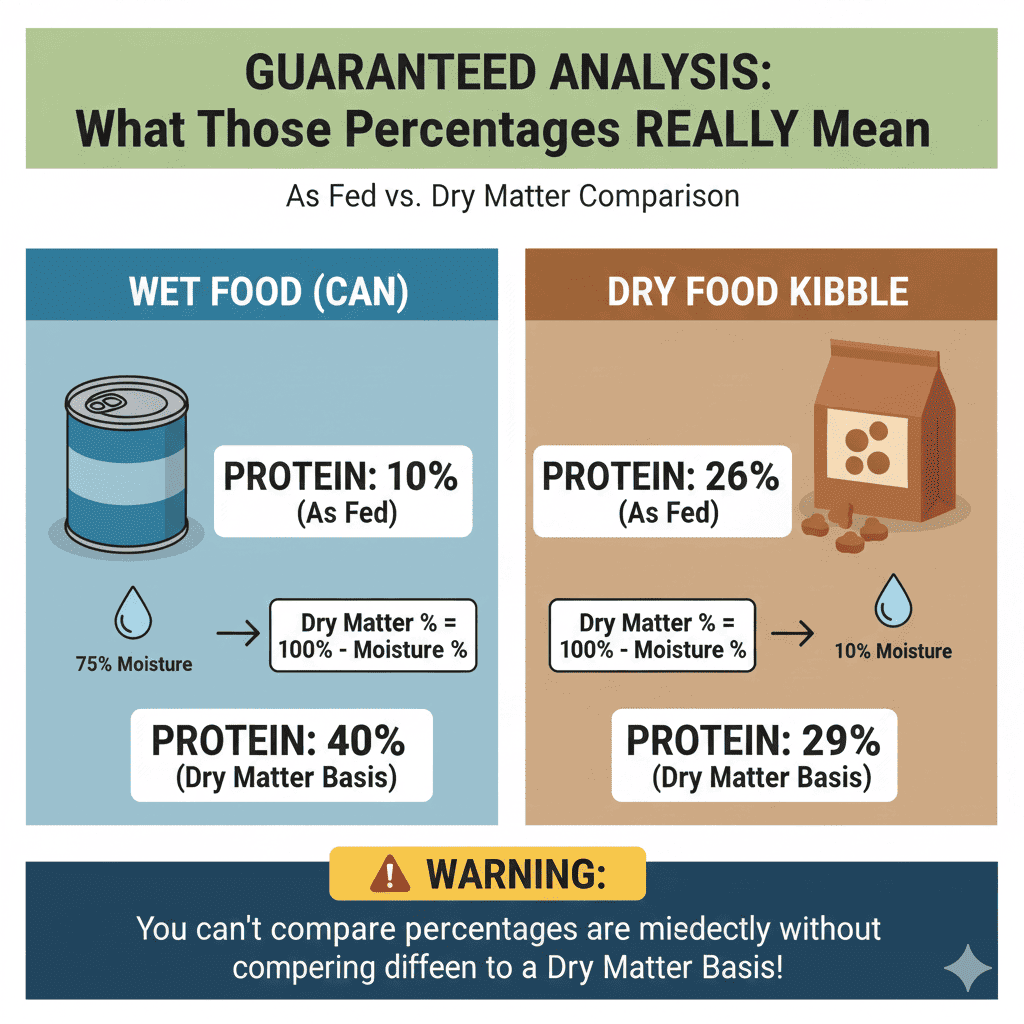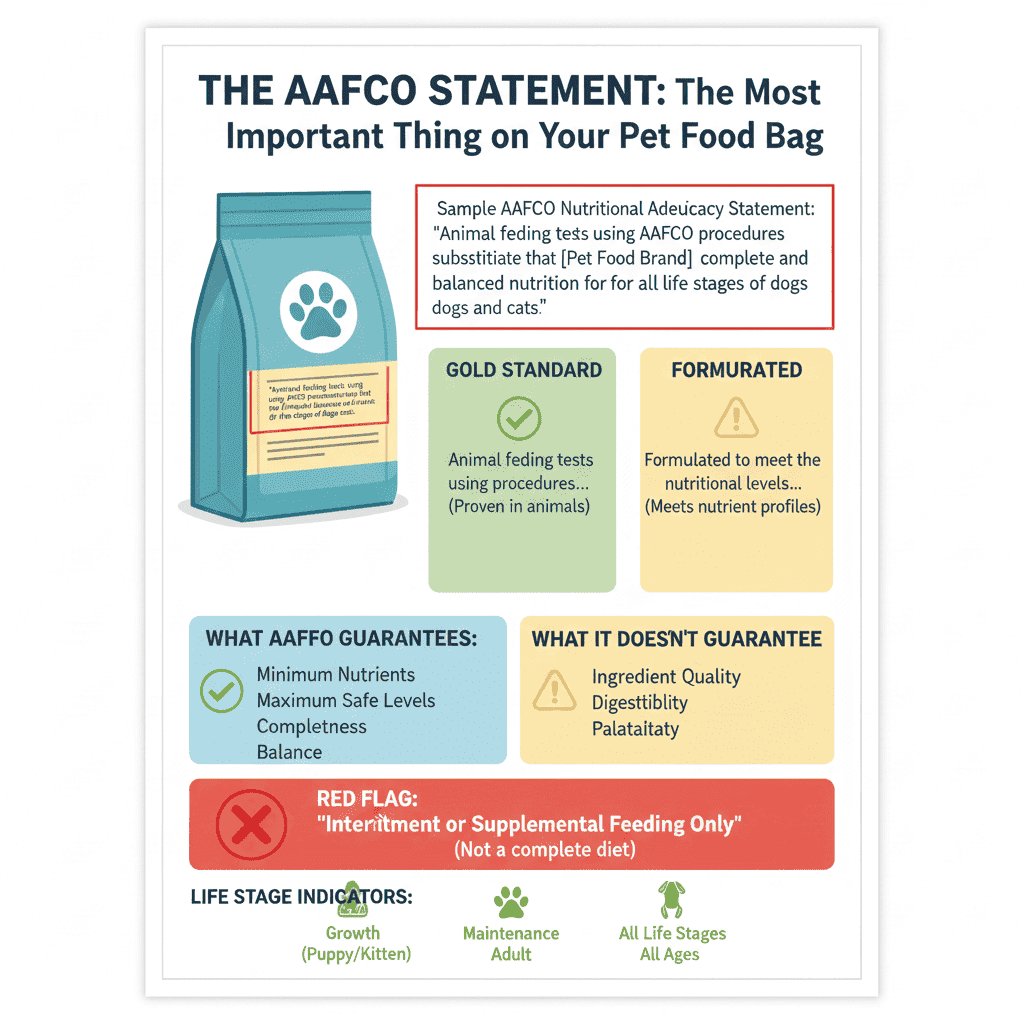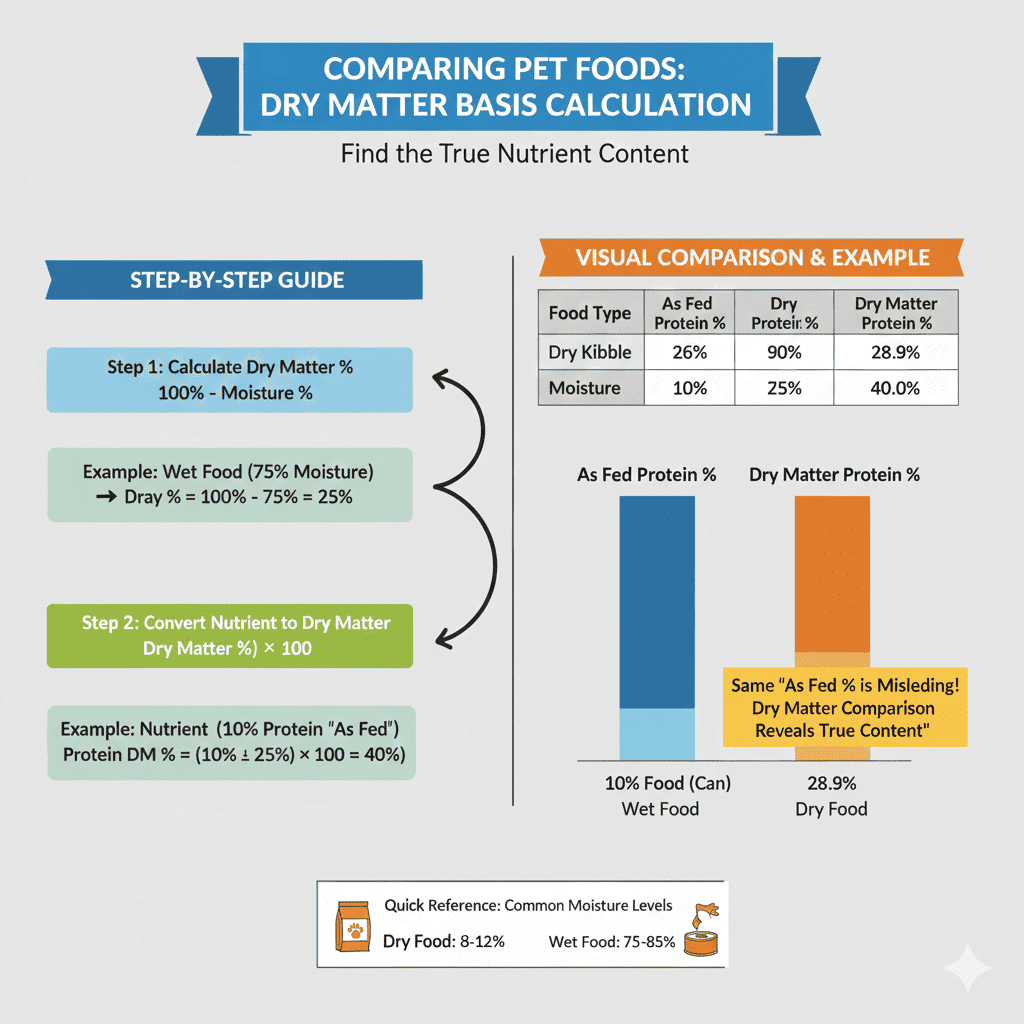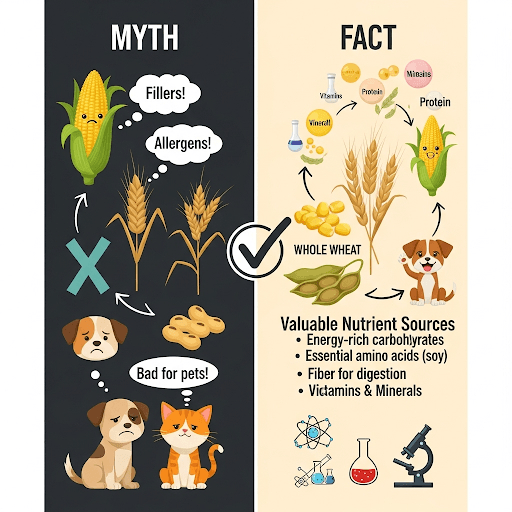You're comparing two pet foods, looking at the guaranteed analysis on the labels. One shows 26% protein, the other shows 30% protein. The choice seems obvious—go with the higher protein, right?
Not so fast. Those percentages aren't what they appear to be, and comparing them directly can lead you to make the wrong choice. The guaranteed analysis is one of the most misunderstood parts of a pet food label, and understanding what it really means is crucial for making informed decisions.
What is the Guaranteed Analysis?
The guaranteed analysis is a required section on all pet food labels that lists the minimum or maximum percentages of certain nutrients. It's called "guaranteed" because the manufacturer guarantees the food contains at least (or at most) the stated amounts.
Required Nutrients
The guaranteed analysis must include:
For all pet foods:
- Crude Protein (minimum %)
- Crude Fat (minimum %)
- Crude Fiber (maximum %)
- Moisture (maximum %)
Additional nutrients may be listed:
- Ash (maximum %)
- Calcium (minimum and/or maximum %)
- Phosphorus (minimum and/or maximum %)
- Other vitamins and minerals

The Critical Problem: "As Fed" vs. "Dry Matter"
Here's where most pet owners get confused: The guaranteed analysis shows percentages "as fed"—meaning they include the water (moisture) in the food.
Why This Matters
Wet food example:
- Contains 75% moisture (water)
- Shows 10% protein "as fed"
- But the dry matter (actual food) is only 25% of the total
- Dry matter protein = 10% ÷ 25% = 40% protein!
Dry food example:
- Contains 10% moisture
- Shows 26% protein "as fed"
- The dry matter is 90% of the total
- Dry matter protein = 26% ÷ 90% = 28.9% protein
The problem: You can't directly compare 10% (wet food) to 26% (dry food) because they have different moisture contents. You need to convert both to "dry matter basis" to make a fair comparison.
Understanding "Crude" Nutrients
The word "crude" in "crude protein," "crude fat," and "crude fiber" doesn't mean "low quality"—it's a scientific term that refers to how the nutrient is measured.
Crude Protein
What it means:
- Measures total nitrogen content (protein contains nitrogen)
- Multiplies nitrogen by 6.25 to estimate protein
- Called "crude" because it doesn't distinguish between different types of protein
What it doesn't tell you:
- ❌ Protein quality (high-quality vs. low-quality sources)
- ❌ Amino acid profile (complete vs. incomplete)
- ❌ Digestibility (how much your pet can actually use)
- ❌ Bioavailability (how efficiently it's absorbed)
Example:
- Food A: 30% crude protein from chicken (high quality, highly digestible)
- Food B: 30% crude protein from corn gluten meal (lower quality, less digestible)
- Same percentage, very different value!
Crude Fat
What it means:
- Measures total fat content
- Includes all types of fats (saturated, unsaturated, omega-3, omega-6)
- Called "crude" because it doesn't specify fat types
What it doesn't tell you:
- ❌ Types of fats (healthy vs. unhealthy)
- ❌ Omega-3 and omega-6 content
- ❌ Fat quality or source
- ❌ Digestibility
Crude Fiber
What it means:
- Measures indigestible plant matter
- Maximum percentage (not minimum)
- Called "crude" because it measures total fiber, not specific types
What it doesn't tell you:
- ❌ Types of fiber (soluble vs. insoluble)
- ❌ Prebiotic effects
- ❌ Digestibility of other nutrients
Moisture
What it means:
- Maximum water content
- Higher in wet foods (typically 75-85%)
- Lower in dry foods (typically 8-12%)
Why it matters:
- Affects all other percentages
- Must be accounted for when comparing foods
- Determines shelf life and storage requirements
How to Convert to Dry Matter Basis
To compare foods accurately, you need to convert percentages to "dry matter basis" (removing the water):
The Formula
Dry Matter % = 100% - Moisture %
Dry Matter Nutrient % = (As Fed Nutrient % ÷ Dry Matter %) × 100
Step-by-Step Example
Comparing two foods:
Food A (Dry):
- Protein: 26% (as fed)
- Moisture: 10%
- Dry matter: 100% - 10% = 90%
- Dry matter protein: (26% ÷ 90%) × 100 = 28.9%
Food B (Wet):
- Protein: 10% (as fed)
- Moisture: 75%
- Dry matter: 100% - 75% = 25%
- Dry matter protein: (10% ÷ 25%) × 100 = 40%
Result: Food B actually has MORE protein than Food A, even though the "as fed" percentages suggested otherwise!
Common Misconceptions
Misconception 1: "Higher percentage = Better quality"
Reality: A higher percentage doesn't guarantee better quality. A food with 30% crude protein from low-quality sources may be worse than a food with 26% crude protein from high-quality sources.
Misconception 2: "I can compare percentages directly"
Reality: You can only compare "as fed" percentages if foods have the same moisture content. Otherwise, convert to dry matter basis.
Misconception 3: "Crude means low quality"
Reality: "Crude" is a scientific measurement term, not a quality indicator. It refers to the measurement method, not the quality of the nutrient.
Misconception 4: "The guaranteed analysis tells me everything"
Reality: The guaranteed analysis is just the beginning. It doesn't tell you about ingredient quality, digestibility, or bioavailability.
What the Guaranteed Analysis Doesn't Tell You
1. Nutrient Quality
Two foods can have the same protein percentage but very different quality:
- High quality: Animal-based proteins (chicken, fish, eggs)
- Lower quality: Plant-based proteins (corn gluten, soy)
2. Digestibility
The guaranteed analysis shows what's IN the food, not what your pet can USE:
- Highly digestible: Your pet absorbs and uses most of it
- Poorly digestible: Much of it passes through undigested
3. Bioavailability
Even if a nutrient is digestible, it may not be bioavailable:
- Bioavailable: Your pet's body can actually use it
- Not bioavailable: Absorbed but not utilized effectively
4. Amino Acid Profile
For protein, the amino acid profile matters more than total percentage:
- Complete protein: Contains all essential amino acids
- Incomplete protein: Missing some essential amino acids
5. Nutrient Interactions
Nutrients work together, not in isolation:
- Calcium and phosphorus ratio: More important than individual amounts
- Vitamins and minerals: Need to be in balance
- Fat-soluble vitamins: Require fat for absorption
How to Use the Guaranteed Analysis Effectively
Step 1: Check Minimums and Maximums
Look for:
- ✅ Adequate minimums (protein, fat)
- ✅ Appropriate maximums (fiber, moisture)
- ⚠️ Extremely high percentages (may indicate poor quality sources)
Step 2: Convert to Dry Matter Basis
When comparing:
- Foods with different moisture contents
- Wet vs. dry foods
- Different brands with different formulations
When you don't need to convert:
- Comparing similar foods (both dry, both wet)
- Same moisture content
Step 3: Consider the Context
Look beyond percentages:
- Check the ingredient list (quality sources?)
- Consider your pet's needs (life stage, activity, health)
- Consult your veterinarian
- Use the guaranteed analysis as ONE factor, not the only factor
Step 4: Understand Your Pet's Needs
Minimum requirements:
- Dogs: 18% protein (dry matter), 5% fat
- Cats: 26% protein (dry matter), 9% fat
But remember:
- Minimums are just that—minimums
- Many pets benefit from higher levels
- Quality matters more than quantity
Special Considerations
Comparing Wet vs. Dry Foods
Always convert to dry matter basis:
- Wet foods appear lower in nutrients (due to high moisture)
- Dry foods appear higher in nutrients (due to low moisture)
- Dry matter basis shows the true comparison
"All Life Stages" Foods
These must meet the highest standards (growth requirements):
- Higher protein and fat than adult-only foods
- May be higher in calories than some adults need
- Check if your adult pet needs this level
Prescription/Therapeutic Foods
These may have:
- Modified nutrient levels for specific conditions
- Lower protein (kidney disease)
- Lower fat (pancreatitis)
- Higher fiber (weight management)
- Always follow veterinary recommendations
Red Flags in Guaranteed Analysis
Warning Signs
Extremely high percentages:
- May indicate poor-quality, indigestible sources
- Could be artificially inflated
Missing information:
- Should include all required nutrients
- Missing data may indicate incomplete formulation
Unrealistic claims:
- "100% protein" (impossible—would be pure meat, not a complete diet)
- Claims that seem too good to be true
The Bottom Line
The guaranteed analysis is a starting point, not the complete picture. Those percentages tell you what's in the food, but not:
- How good the quality is
- How digestible it is
- How bioavailable it is
- Whether it meets your pet's specific needs
Key takeaways:
- ✅ Always convert to dry matter basis when comparing foods with different moisture contents
- ✅ Understand that "crude" is a measurement term, not a quality indicator
- ✅ Remember that percentage doesn't equal quality
- ✅ Use guaranteed analysis as ONE factor in choosing food
- ✅ Consider ingredient quality, digestibility, and your pet's needs
The guaranteed analysis is a tool, not an answer. Use it wisely, in combination with ingredient lists, AAFCO statements, and your veterinarian's guidance, to make the best choice for your pet.
Ready to find foods that meet your pet's nutritional needs? Use our pet meal planner to discover options tailored to your pet's unique requirements, and let us help you understand what those percentages really mean for your pet's health.
For more information on comparing foods accurately, see our article: How to Compare Foods on a Dry Matter Basis.


